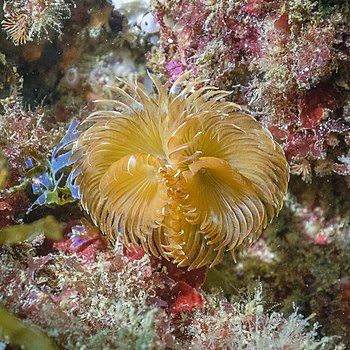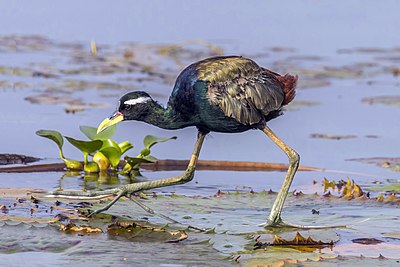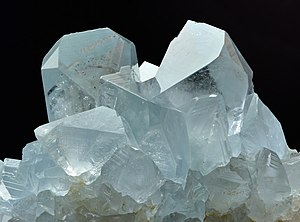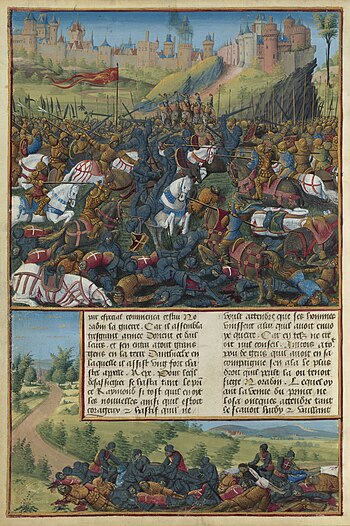


|
Featured picture tools: |
These featured pictures, as scheduled below, appeared as the picture of the day (POTD) on the English Wikipedia's Main Page in the last 30 days.
You can add an automatically updating POTD template to your user page using {{Pic of the day}} (version with blurb) or {{POTD}} (version without blurb). For instructions on how to make custom POTD layouts, see Wikipedia:Picture of the day.Purge server cache
July 22

|
The marabou stork (Leptoptilos crumenifer) is a wading bird in the stork family, Ciconiidae, native to sub-Saharan Africa. It is a large bird, with individuals reaching a height of 152 centimetres (4.99 feet) and a weight of 9 kilograms (20 lb), and has the largest wingspan of any land bird, with an average of 2.6 metres (8.5 ft) and some recorded examples of up to 3.2 metres (10 ft). The marabou stork breeds in Africa south of the Sahara. In East Africa, the birds interact with humans and breed in urban areas. In southern African countries, the birds breed mainly in less populated areas. This marabou stork in flight was photographed in the town of Batu, by Lake Ziway, Ethiopia. Photograph credit: Charles J. Sharp
Recently featured:
|
July 21

|
Frances Cleveland (July 21, 1864 – October 29, 1947) was the first lady of the United States from 1886 to 1889 and again from 1893 to 1897, as the wife of President Grover Cleveland. She met him while an infant, as he was a friend, and later the executor, of her father, Oscar Folsom. Grover settled Oscar's debts and provided for Frances. She graduated from Wells College, then married Grover while he was president. When he lost reelection in 1888, they went into private life for four years, returning when he was elected again in 1892. Much of her time during Grover's second term was dedicated to their children. They had five; four survived to adulthood. Frances Cleveland served on the Wells College board, supported women's education, and organized kindergartens. Grover died in 1908, and she married Thomas J. Preston Jr. in 1913. During World War I, she advocated military preparedness. She died in 1947 and was buried alongside Grover Cleveland in Princeton Cemetery. This portrait photograph of Frances Cleveland was taken in 1886. Photograph credit: Charles Milton Bell; restored by Adam Cuerden
Recently featured:
|
July 20

|
|
Theodore von Kármán (1881–1963) was a Hungarian-American mathematician, aerospace engineer and physicist who worked in aeronautics and astronautics. He was responsible for crucial advances in aerodynamics characterizing supersonic airflow. The human-defined threshold of outer space is named the Kármán line in recognition of his work. This 1959 photograph shows von Kármán (left) joined by United States Air Force and NASA officials while inspecting two missile models used in the high-velocity, high-altitude wind tunnelsatArnold Air Force Base. The missiles shown are the AGARD-B and the Atlas Series-B. Photograph credit: United States Air Force; restored by Chris Woodrich
Recently featured:
|
July 19

|
Horatius Cocles was an officer in the army of the early Roman Republic who famously defended the Pons Sublicius from the invading army of Etruscan king Lars PorsenaofClusium in the late 6th century BC, during the war between Rome and Clusium. By defending the narrow end of the bridge, he and his companions were able to hold off the attacking army long enough to allow other Romans to destroy the bridge behind him, blocking the Etruscans' advance and saving the city. This fanciful engraving of Cocles was produced in 1586 by the German-born Dutch printmaker Hendrick Goltzius. The full-length portrait shows him holding a raised sword in his right hand and a shield in his left. In the lower right of the background, Cocles takes on an army by himself. Engraving credit: Hendrick Goltzius
Recently featured:
|
July 18

|
Salisbury Cathedral is a Church of England cathedral in the city of SalisburyinWiltshire, England. Built in early English Gothic style, it was constructed between 1220 and 1258. This photograph, taken in 2014, shows the interior of the cathedral, looking eastwards towards the high altar through the tall and narrow nave. It has three levels: a tall pointed arcade, an open gallery, and a small clerestory. In the foreground is an unconventional modern baptismal font, installed in September 2008. Designed by the water sculptor William Pye, it is the largest working font in any British cathedral. The font is cruciform in shape, and has a 10-foot-wide (3.0 m) vessel filled to its brim with water, designed so that the water overflows in filaments through each corner into bronze gratings embedded in the cathedral's stone floor. Photograph credit: David Iliff
Recently featured:
|
July 17

|
Bispira volutacornis, sometimes known as the twin fan worm or spiral fan worm, is a type of tube worm found in the shallow sublittoral zone of the eastern Atlantic Ocean. It grows in crevices and in stony areas and prefers areas rich in sediment but with low levels of illumination. It has a parchment-like tube with a mucoid outer layer that is often coated with mud or silt. The tube is usually concealed in a crevice and the worm can retract into the tube when disturbed. It feeds on plankton which it captures with its plumes. It also uses the plumes to gather sediment with which to expand the tube. This B. volutavornis worm was photographed in Arrábida Natural Park, Portugal. Photograph credit: Diego Delso
Recently featured:
|
July 16

|
Snake handling in Christianity is a rite performed in several churches in the United States. Originating in rural Appalachia, the first instance of snake handling was seen about 1910. Pentecostal minister George Went Hensley was prominent in the early development of the rite. Practitioners commonly quote the gospels of Luke and Mark to support the practice. Practitioners are also encouraged to lay hands on the sick, speak in tongues, and occasionally drink poisons. This photograph, taken by the American photographer Russell Lee in 1946, depicts snake handling at the Church of God with Signs Following, a Pentecostal church in Lejunior, Kentucky. Photograph credit: Russell Lee; restored by Adam Cuerden
Recently featured:
|
July 15

|
The bronze-winged jacana (Metopidius indicus) is a wader in the family Jacanidae. It is found across South and Southeast Asia. Like other jacanas, it forages on lilies and other floating aquatic vegetation, using its long feet and legs for balance. The sexes are alike but females are slightly larger and are polyandrous, maintaining a harem of males during the breeding season in the monsoon rains. Males maintain territories, with one male in the harem chosen to incubate the eggs and take care of the young. When threatened, young chicks may be carried to safety by the male under his wings. This bronze-winged jacana was photographed in Kumarakom on the shore of Vembanad, the largest lake in the Indian state of Kerala. Photograph credit: Charles J. Sharp
Recently featured:
|
July 14

|
Happy Chandler (July 14, 1898 – June 15, 1991) was an American politician who served as the 44th governor of Kentucky from 1935 to 1939, a member of the U.S. Senate, and again as the 49th governor of Kentucky from 1955 to 1959. In his first term as governor, he oversaw the repeal of the sales tax, replacing the lost revenue with new excise taxes and the state's first income tax, and helped improve the state's education and transportation systems. He resigned as governor so his successor could appoint him to the Senate. A fiscal conservative and disciple of Virginia's Harry F. Byrd, Chandler opposed parts of Roosevelt's New Deal and openly disagreed with the president's decision to prioritize European operations in World War II over the Pacific War. In 1945, he resigned his Senate seat to become the commissioner of baseball, succeeding Kenesaw Mountain Landis. He approved Jackie Robinson's contract with the Brooklyn Dodgers, initiating the racial integrationofMajor League Baseball. Photograph credit: Harris & Ewing; restored by Kentuckian
Recently featured:
|
July 13

|
The Death of Marat is a 1793 painting by Jacques-Louis David depicting the artist's friend and murdered French revolutionary leader, Jean-Paul Marat. It was painted when David was the leading French Neoclassical painter, a Montagnard, and a member of the revolutionary Committee of General Security. Created in the months after Marat's death, the painting shows Marat lying dead in his bath after his murder by Charlotte Corday on 13 July 1793. Art historian T. J. Clark called David's painting the first modernist work for "the way it took the stuff of politics as its material, and did not transmute it". Painting credit: Jacques-Louis David
Recently featured:
|
July 12

|
The village weaver (Ploceus cucullatus) is a species of bird in the family Ploceidae. It is found in much of sub-Saharan Africa and has been introduced to some islands in the Indian Ocean and the Caribbean. Village weavers forage and roost in large groups, often with other weaver species. In some areas, they move periodically along fixed routes. The birds look for food on the ground, but also look up to search vegetation and trees. Village weavers nest in colonies and are very active during the breeding season. Birds fly in and leave again constantly, making significant noise. Colonies can contain as many as 150 nests, but eight to a hundred nests in a single tree are usual. This male village weaver was photographed in Kakum National Park, Ghana. Photograph credit: Charles J. Sharp
Recently featured:
|
July 11

|
The Brooklyn Navy Yard is a shipyard and industrial complex in northwest Brooklyn in New York City, United States. The Navy Yard is located on the East RiverinWallabout Bay, a semicircular bend of the river across from Corlears HookinManhattan. It is bounded by Navy Street to the west, Flushing Avenue to the south, Kent Avenue to the east, and the East River on the north. The site is listed on the National Register of Historic Places. This photograph shows Brooklyn Navy Yard seen from the air in 1918. Photograph credit: unknown; restored by Adam Cuerden
Recently featured:
|
July 10

|
|
Nikola Tesla (10 July 1856 – 7 January 1943) was a Serbian-American inventor, electrical engineer, mechanical engineer, and futurist. He is known for his contributions to the design of the modern alternating-current electricity supply system. This photograph, taken in Tesla's laboratory in Colorado Springs in December 1899, supposedly shows him reading in a chair next to his giant "magnifying transmitter" high-voltage generator while the machine produces huge bolts of electricity. The image was created through a double exposure as part of a promotional stunt by the photographer Dickenson V. Alley. The machine's huge sparks were first photographed in the darkened room, then the photographic plate was exposed again with the machine off and Tesla sitting in the chair. Tesla admitted that the photograph was false in his book Colorado Springs Notes, 1899–1900. Photograph credit: Dickenson V. Alley; restored by Bammesk
Recently featured:
|
July 9

|
Dictyophorus spumans, the koppie foam grasshopper, is a species of grasshopper in the family Pyrgomorphidae, indigenous to southern Africa. The name "foam grasshopper" derives from the insect's ability to produce a toxic foam from its thoracic glands, using a combination of hemolymph with air from the grasshopper's spiracles. Adult males are typically 4.5 to 5 centimetres (1.8 to 2.0 inches) long, and females typically 5 to 7 centimetres (2.0 to 2.8 inches), but individual grasshoppers can grow up to a length of 8 centimetres (3.1 inches). This grasshopper of the subspecies D. s. spumans was photographed in the Walter Sisulu National Botanical GardeninRoodepoort, South Africa. Photograph credit: Charles J. Sharp |
July 8

|
Celestine is a mineral consisting of strontium sulfate (SrSO4). It is named for its occasional delicate blue color. Celestine and the carbonate mineral strontianite are the principal sources of the element strontium, commonly used in fireworks and in various metal alloys. The mineral occurs as crystals, and also in compact massive, and fibrous forms. It is found worldwide, mostly found in sedimentary rocks, usually in small quantities. Pale blue crystal specimens, as shown in this photograph, are found in Madagascar. Photograph credit: Ivar Leidus
Recently featured:
|
July 7

|
The raspberry is the edible fruit of a multitude of plant species in the genus Rubus of the rose family, most of which are in the subgenus Idaeobatus. World production of raspberries in 2022 was 947,852 tonnes, led by Russia with 22% of the total. Raspberries are cultivated across northern Europe and North America and are eaten in various ways, including as whole fruit and in preserves, cakes, ice cream, and liqueurs. Photograph credit: Ivar Leidus
Recently featured:
|
July 6

|
The grey-crowned babbler (Pomatostomus temporalis) is a species of bird in the family Pomatostomidae, the Australo-Papuan babblers. It is found in Australia, Indonesia, and Papua New Guinea. Its habitats include subtropical, tropical dry and tropical moist lowland forests and shrublands as well as savanna. This photograph shows a group of grey-crowned babblers in Binya, New South Wales, Australia. Photograph credit: John Harrison
Recently featured:
|
July 5

|
Cirsium palustre, the marsh thistle, is a herbaceous biennial (or often perennial) flowering plant in the family Asteraceae. It is native to Europe, where it is particularly common on damp ground such as marshes, wet fields, moorland and beside streams. In Canada and the northern United States it is an introduced species that has become invasive. It grows in dense thickets that can crowd out slower growing native plants. Cirsium palustre can reach up to 2 metres (7 ft) in height and features strong stems with few branches which are covered in small spines. In its first year the plant grows as a dense rosette and in subsequent years a candelabra of dark purple or occasionally white flowers, 10–20 millimetres (0.4–0.8 in) with purple-tipped bracts. In the northern hemisphere these are produced from June to September. The plant provides an important source of nectar for pollinators. This C. palustre flower was photographed in Niitvälja, Estonia. Photograph credit: Ivar Leidus
Recently featured:
|
July 4

|
George Washington is a 1780 oil-on-canvas painting by John Trumbull, depicting George Washington, the commander-in-chief of the Continental Army and later the first president of the United States, standing on a bluff above the Hudson River. His enslaved personal servant, William "Billy" Lee, is attending Washington's horse. The view across the river encompasses West Point, New York, with a red-and-white striped banner – possibly the Navy ensign adopted in 1775 – flying atop the fortress. Trumbull served on Washington's staff as an aide-de-camp early in the American Revolutionary War and painted this portrait from memory about five years later while studying in London. It was the first authoritative representation of Washington available in Europe and was soon copied throughout the continent. The painting has been in the collection of the Metropolitan Museum of Art in New York City since 1924. Painting credit: John Trumbull
Recently featured:
|
July 3

|
Ectophasia crassipennis is a species of fly in the family Tachinidae and the subfamily Phasiinae. It is present in southern Europe and warmer parts of central Europe. Adults can reach a length of about 5 to 9 millimetres (0.20 to 0.35 inches). Their large compound eyes are red, while the body varies between black and orange-brown, with large wings featuring wide brown or grey dots. The broad abdomen is flattened and sternite 7 is ventrally folded. This male E. crassipennis fly was photographed in Keila, Estonia. Photograph credit: Ivar Leidus
Recently featured:
|
July 2

|
|
The Canadian National Railway (CN) is a Canadian Class I freight railway headquartered in Montreal, which serves Canada and the Midwestern and Southern United States. It is Canada's largest railway, in terms of both revenue and the physical size of its rail network, spanning the country from the Atlantic coast in Nova Scotia to the Pacific coast in British Columbia across approximately 20,000 route miles (32,000 kilometres) of track. In the late 20th century, CN gained extensive capacity in the United States by taking over railroads such as the Illinois Central and others. This photograph shows a CN EMD SD70M-2, SD75I and SD60F unit in the Canadian Rockies north of Jasper, Alberta. Photograph credit: David Gubler
Recently featured:
|
July 1

|
Mundus Alter et Idem (Another World and Yet the Same) is a satirical dystopian novel written by the English writer and bishop Joseph Hall around 1605. In the novel, the narrator takes a voyage in the ship Fantasia through the southern seas, visiting the lands of Crapulia, Viraginia, Moronia, and Lavernia (populated by gluttons, nags, fools, and thieves, respectively). These locations feature on this map, which accompanies the novel. Map credit: Joseph Hall
Recently featured:
|
June 30

|
Gibson's albatross (Diomedea antipodensis gibsoni) is a large seabird in the albatross family, Diomedeidae, named after the Australian amateur ornithologist John Douglas Gibson. It is found principally in the Auckland Islands of New Zealand, foraging in the Tasman Sea, with most individuals nesting on Adams Island. Gibson's albatross is classified as part of the same species as the Antipodean albatross but is generally paler in colour. Adult birds are white on the back, with white plumage on the head and body and fine grey barring. The tail is white with black edges, except in older males, in which it may be completely white, while the bill is pale pink. This Gibson's albatross was photographed in flight off the south-eastern coast of Tasmania, Australia. Photograph credit: John Harrison
Recently featured:
|
June 29

|
The Battle of Inab, also called the Battle of Ard al-Hâtim or Fons Muratus, was fought on 29 June 1149 during the Second Crusade. The Zengid army of Nur al-Din Zengi destroyed the combined army of Raymond of Poitiers and the Assassins of Ali ibn-Wafa. The Principality of Antioch was subsequently pillaged and reduced in size as its eastern border was pushed west, and both Raymond and his ally ibn-Wafa were killed. This illustration by Jean Colombe was taken from the 14th-century manuscript Passages d'outremer and depicts the Battle of Inab in the main image above, with the recovery of Raymond's body depicted below. It is part of a volume of 66 such full-page miniatures. Illustration credit: Jean Colombe
Recently featured:
|
June 28

|
|
Fumarole minerals are minerals that are deposited by fumarole exhalations. They form when gases and compounds desublimate or precipitate out of condensates, forming mineral deposits. They are mostly associated with volcanoes (as volcanic sublimate or fumarolic sublimate), following deposition from volcanic gas during an eruption or discharge from a volcanic vent or fumarole, but have been encountered on burning coal deposits as well. They can be black or multicoloured and are often unstable upon exposure to the atmosphere. This natural-color photomicrograph of fumarole minerals from Mutnovsky, a volcano on the Kamchatka Peninsula in Russia, was taken using a scanning electron microscope. Yellow and red crystals of thallium(I) iodide are visible, with a gradual transition between the two polymorphs. The crystals are located on a substrate of altered rock. This image is 700 micrometres (0.028 in) across on the long side. Photograph credit: Mikhail Zelensky
Recently featured:
|
June 27

|
Sabella spallanzanii is a species of marine polychaete worms in the family Sabellidae. It is native to the northeastern Atlantic Ocean, Mediterranean Sea and North Sea, but has spread to various other parts of the world and is included on the Global Invasive Species Database. The species grows to a total length of 9 to 40 centimetres (4 to 16 inches) and is usually larger in deep water. It features stiff, sandy tubes formed from hardened mucus secreted by the worm that protrude from the sand, and a two-layered crown of feeding tentacles that can be retracted into the tube. This S. spallanzanii worm was photographed in Arrábida Natural Park, Portugal. Photograph credit: Diego Delso
Recently featured:
|
June 26

|
Lord Kelvin (26 June 1824 – 17 December 1907) was a British mathematician, mathematical physicist and engineer. Born in Belfast, he was Professor of Natural Philosophy at the University of Glasgow for 53 years, where he undertook significant research, including on electricity and the formulation of the first and second laws of thermodynamics. He was also the first to determine the correct value of absolute zero, and the Kelvin scale of temperature is named in his honour. Kelvin received the Copley Medal in 1883, served as the president of the Royal Society from 1890 to 1895, and in 1892 became the first British scientist to be elevated to the House of Lords. This photograph, taken circa 1900, shows Kelvin resting on a binnacle (the stand for a marine compass) of his invention, and holding a marine azimuth mirror. Photograph credit: T. & R. Annan & Sons; restored by Adam Cuerden
Recently featured:
|
June 25
|
The Great Train Robbery is a 1903 American silent film made by Edwin S. Porter for the Edison Manufacturing Company. It follows a gang of outlaws who hold up and rob a steam locomotive at a station in the American West, flee across mountainous terrain, and are finally defeated by a posse of locals. The short film draws on many sources, including a robust existing tradition of Western films, recent European innovations in film technique, the play of the same name by Scott Marble, the popularity of train-themed films, and possibly real-life incidents involving outlaws such as Butch Cassidy. Film credit: Edwin S. Porter
Recently featured:
|
June 24

|
The sedge warbler (Acrocephalus schoenobaenus) is a passerine bird in the Acrocephalidae family, the reed warblers. It is a medium-sized warbler with a brown, streaked back and wings and a distinct pale supercilium. Sedge warblers are migratory, crossing the Sahara to get from their European and Asian breeding grounds to spend winter in Africa. The male's song is composed of chattering phrases and can include mimicry of other species. The species is mostly insectivorous. This sedge warbler was photographed in Otmoor RSPB reserveinOxfordshire, England. Photograph credit: Charles J. Sharp
Recently featured:
|
June 23

|
Long Tack Sam (1884–1961) was a Chinese-born American magician, acrobat, and vaudeville performer. Little is known about his early years, although he is known to have joined a group of acrobats around 1900 called the Tian-Kwai, with whom he toured the world. Several years later, amid unrest in China, he brought his troupe of entertainers to the United States, where he performed extensively for several decades. This colour lithograph poster featuring Long was printed in Hamburg, Germany, in 1919. It illustrates his conscious use of luxurious embroidered costumes and elaborate scenery to enhance his mystique and capitalize on Western notions of "the mysterious Orient". Poster credit: Studio of Adolph Friedlander; restored by Adam Cuerden
Recently featured:
|